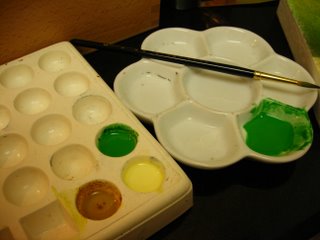Egg Tempera Painting
In the fall of 2001 I enrolled in an egg tempera class. It had been recommended to me by my drawing teacher since at that time I was very into traditional painting and drawing. Fred Wessel became my teacher and the man taught me so much. During his class I was only able to complete one small painting out three projects he had assigned, but it was enough for me to learn the technique. Two years ago I decided to see if I still had it in me and painted my second egg tempera painting. Now I'm coming back for more.
Egg Tempera is one of the oldest forms of painting known to man. A method highly used during the Renaissance before the introduction of oil paint. This method consists of mixing pigments (powder colors) and pure egg as a binder. Much different than oil, this technique requires patience, and if you are working along traditional lines, a high degree of rendering. Although using a small brush for crosshatching the color may seem pain staking and long, a lot can be done in one session. Oils take some time to dry, and if you are the kind of artist who likes to glaze you would probably have to paint for a while to add layer upon layer. With egg tempera the paint dries to the touch within a minute, allowing you to keep adding as many layers as possible. The only trick is not to keep working on the same area because at some point the paint reactivates and all layers come right off with the brush, exposing the gesso ground underneath. Another good thing about this paint is that pigments are less affected by the binding medium. Colors retain their natural radiance as found in the dry form.
The support for egg tempera is a wood panel. Over time the paint film becomes brittle and a stiff painting support assures the longevity of the work. After the preparation of the panel I start by making a quick drawing for the subject. This is the beginning of the underpainting.
The underpainting is achieved by going over the drawing with ink. This is mainly to establish all the values. As you can see form my underpainting it is not too developed, you don't have to take it that far. It's just to give you an idea. In this underpainting I've used India Ink. This is the building block of the painting; from here on end everything will be about glazing and building up the colors by crosshatching.






Comments